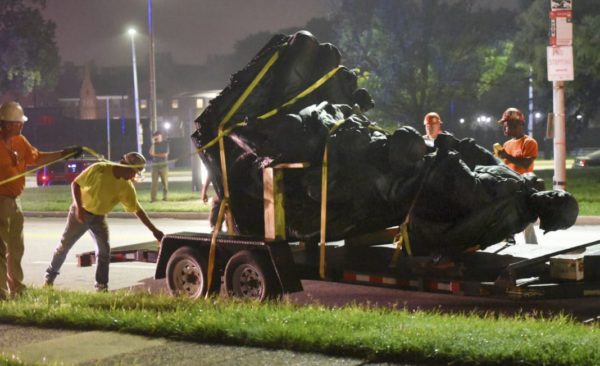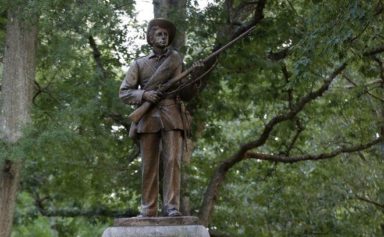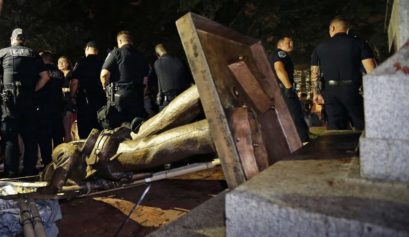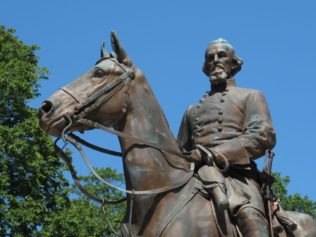
Workers remove a monument dedicated to the Confederate Women of Maryland early, after it was taken down in Baltimore.(Jerry Jackson/The Baltimore Sun via AP, File)
Protesters at North Carolina’s flagship university toppled a Confederate statue in the heart of campus that has long been a subject of controversy and that officials said couldn’t be removed because of state law.
Videos from Monday night showed a crowd at the University of North Carolina at Chapel Hill yanking down the memorial known as “Silent Sam.” The bronze figure of a southern soldier atop a tall stone pedestal was erected by the United Daughters of the Confederacy in 1913. Earlier this year, a protester was arrested after throwing a mixture of red ink and her own blood on “Silent Sam.”
North Carolina has been one of several focal points in the renewed national debate over Confederate monuments following a deadly white nationalist protest a year ago in Charlottesville, Virginia, and the 2015 massacre of black worshippers at a South Carolina church by an avowed white supremacist.
Here is a look at ways other communities across the U.S. have removed many Confederate monuments:
DURHAM, NORTH CAROLINA
Two days after the violent “Unite the Right” rally in Charlottesville, an angry crowd gathered around a monument to Confederate soldiers outside a former courthouse building in Durham, about 15 miles (24 kilometers) from Chapel Hill. A woman climbed a ladder and attached a rope to the bronze statue, and protesters yanked it down. A dozen protesters were charged with crimes in the monument takedown, but none of the cases stuck.
BALTIMORE
Following the 2015 slayings at the historic Emanuel AME Church in Charleston, Baltimore named a special commission that spent a year reviewing four Confederate monuments on city property. The panel ultimately urged keeping two monuments, with some changes, and removing two others. But Mayor Catherine Pugh ordered all four taken down on Aug. 15, 2017, following the Charlottesville rally, saying she was concerned that such statues might spark violence. City crews dismantled them in the dead of night.
NEW ORLEANS
New Orleans removed three monuments honoring Confederate leaders and one heralding white supremacy before the Charlottesville rally, also in overnight operations. Mayor Mitch Landrieu called for the monuments’ removal in the aftermath of the Charleston shooting. Landrieu, who drew blistering criticism from monument supporters and even some political allies, repeatedly said the monuments do not represent the diversity and future of New Orleans.
MEMPHIS, TENNESSEE
Memphis city leaders found a way around a state law prohibiting the removal of monuments to U.S. military figures on public land. On Dec. 20, the city sold two public parks for $1,000 apiece to a nonprofit group. Almost immediately, the new owner took down a statue of Confederate Gen. Nathan Bedford Forrest, who had also been a slave trader and Ku Klux Klan leader, as well as statues of Confederate President Jefferson Davis and Capt. J. Harvey Mathes.
DALLAS
Last September, crews removed a statue of Robert E. Lee from a pedestal and carted it away from a Dallas park named for the Confederate general. In an unannounced but expected move, a large crane was brought through the city by a police escort to the park to lift the monument away. Soon after, the park itself was renamed.
HELENA, MONTANA
The city removed a granite fountain shortly after the Charlottesville rally that had stood in a park as a monument to Confederate soldiers since 1916.
ANNAPOLIS, MARYLAND
A statue of U.S. Supreme Court Justice Roger Taney, who wrote the 1857 Dred Scott decision that upheld slavery and denied citizenship to African-Americans, was removed from the grounds of the Maryland statehouse and trucked away to storage last August. Three of four voting members of the State House Trust voted to move the bronze statue, which was erected in 1872.


